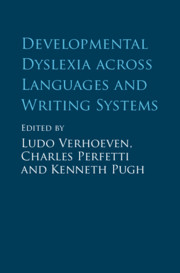Book contents
- Developmental Dyslexia across Languages and Writing Systems
- Developmental Dyslexia across Languages and Writing Systems
- Copyright page
- Contents
- Figures
- Tables
- Contributors
- 1 Introduction
- Part I Developmental Dyslexia across Languages and Writing Systems
- 2 Developmental Dyslexia in English
- 3 Developmental Dyslexia in French
- 4 Developmental Dyslexia in Dutch
- 5 Developmental Dyslexia in Czech and Slovak
- 6 Developmental Dyslexia in Finnish
- 7 Developmental Dyslexia in Russian
- 8 Developmental Dyslexia in Hebrew
- 9 Developmental Dyslexia in Japanese
- 10 Developmental Dyslexia in Chinese
- Part II Cross-Linguistic Perspectives on Developmental Dyslexia
- Epilogue
- Index
- References
8 - Developmental Dyslexia in Hebrew
from Part I - Developmental Dyslexia across Languages and Writing Systems
Published online by Cambridge University Press: 27 September 2019
- Developmental Dyslexia across Languages and Writing Systems
- Developmental Dyslexia across Languages and Writing Systems
- Copyright page
- Contents
- Figures
- Tables
- Contributors
- 1 Introduction
- Part I Developmental Dyslexia across Languages and Writing Systems
- 2 Developmental Dyslexia in English
- 3 Developmental Dyslexia in French
- 4 Developmental Dyslexia in Dutch
- 5 Developmental Dyslexia in Czech and Slovak
- 6 Developmental Dyslexia in Finnish
- 7 Developmental Dyslexia in Russian
- 8 Developmental Dyslexia in Hebrew
- 9 Developmental Dyslexia in Japanese
- 10 Developmental Dyslexia in Chinese
- Part II Cross-Linguistic Perspectives on Developmental Dyslexia
- Epilogue
- Index
- References
Summary
Research on Hebrew-speaking dyslexics, in many ways, is a microcosm of dyslexia research in the mainstream English-language literature. Familiar universal themes are evident, such as phonology and morphology, together with the current “race” to identify basic underlying perceptual and brain mechanisms of dyslexia, which has yet to reach consensus. Less familiar language-specific/script-specific issues are also apparent, such as diacritics and homography. Several original, “homegrown” theories have emerged regarding the underlying mechanisms of dyslexia as well as a novel subtyping scheme. We begin by outlining the characteristics of the Hebrew language and writing system before sketching the process of learning to read. A third section provides a brief historical survey of the legislative and service-delivery frameworks that have evolved over the years since the establishment of the State of Israel in 1948. Identification and assessment of dyslexia are then considered, followed by a review of a second generation of behavioral and neurocognitive research published since a previous review (Share, 2003).
- Type
- Chapter
- Information
- Developmental Dyslexia across Languages and Writing Systems , pp. 152 - 175Publisher: Cambridge University PressPrint publication year: 2019
References
- 5
- Cited by

